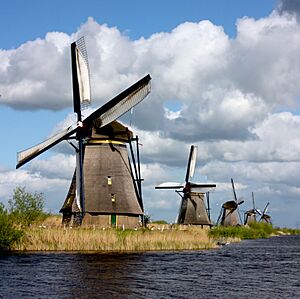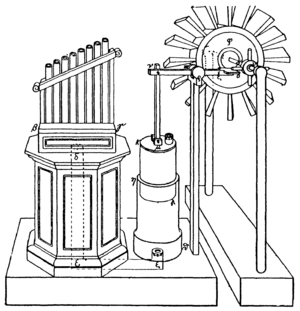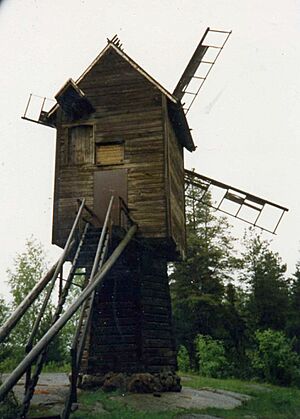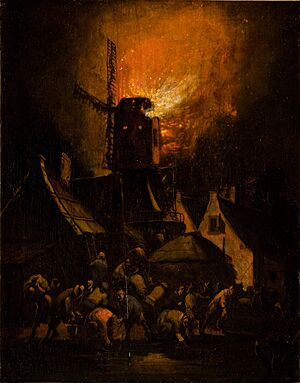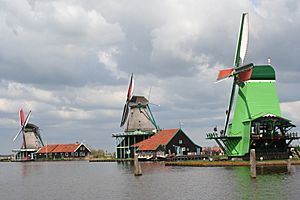Windmill facts for kids
A windmill is a special building or machine that uses the power of the wind to do work. It has large parts called sails or blades that spin when the wind blows. This spinning motion creates energy that can be used for different tasks.
Originally, windmills were mostly used to grind grain into flour. This is why they are called "mills." But over time, the word "windmill" also started to include machines that pump water (called windpumps) or create electricity (called wind turbines).
Windmills have been around for a long time. The first ones appeared in Persia in the 800s. Vertical windmills, which are more common today, started in Europe in the 1100s. The Netherlands is famous for its windmills, and about 1,000 of them are still standing there today.
Contents
Early Wind Machines
People might have known about wind-powered machines even earlier than the 800s. For example, a scientist named Hero of Alexandria in ancient Egypt described a wheel that seemed to be moved by wind. This was around the first century AD. It might have been a toy or just an idea for a machine.
Another early wind-powered device was the prayer wheel. These are believed to have been first used in Tibet and China. We are not sure exactly when they first appeared, but it could have been as early as the 400s.
One of the first real working windmills was invented in Persia (modern-day Iran) between 700 and 900 AD. This type of windmill had vertical sails that spun around a central pole. It was first used to pump water and later to grind grain.
Horizontal Windmills
The first practical windmills were called panemone windmills. Their sails spun around a pole that stood straight up (a vertical axis). These sails were often made of reed mats or cloth. They were used to grind grain or lift water.
Records from the 800s show that windmills were used in Khorasan, a region in Eastern Iran and Western Afghanistan. These windmills became very common across the Middle East and Central Asia. Later, they spread to Europe, China, and India. By the 1000s, this type of windmill had reached parts of Southern Europe.
Some horizontal windmills were also built in Europe in the 1700s and 1800s. These seemed to be new inventions, not directly copied from the older Persian designs.
Vertical Windmills
The vertical windmill is a different type. Its sails spin around a horizontal pole, making them look like they are moving up and down. This type of windmill first appeared in northwestern Europe around the 1100s. This area includes northern France, eastern England, and Flanders (part of modern-day Belgium).
We don't know for sure if the European vertical windmill was inspired by the horizontal windmills from Persia.
The oldest clear record of a windmill in Northern Europe is from 1185. It was in a village called Weedley in Yorkshire, England. These early European windmills were mainly used to grind cereals into flour.
Post Mill
The earliest type of European windmill was the post mill. It gets its name from a large, upright post. The main part of the mill, which holds all the machinery, sits on top of this post. This design allows the whole mill to turn so its sails can face the wind. This was very important in Europe, where wind directions change often.
At first, the post was buried in an earth mound to keep it steady. Later, a wooden support structure called a trestle was developed. This trestle was often covered by a roundhouse. The roundhouse protected the wood from the weather and provided storage space. Post mills were the most common type in Europe until the 1800s. Then, stronger tower and smock mills started to replace them.
Hollow-post mill
A hollow-post mill is a special kind of post mill. Its main post is hollow inside. This allows a drive shaft to pass through it. This design makes it possible to power machinery located below or outside the main mill body. Hollow-post mills were used in the Netherlands from the 1400s to drain wet lands.
Tower Mill
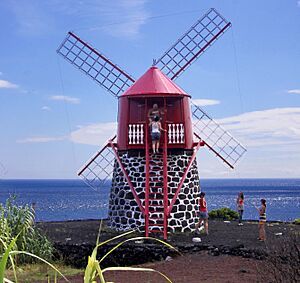

By the late 1200s, the tower mill was invented. This type of mill has a strong stone tower. Only the top part, called the cap, turns to face the wind. This design made the mill much taller and more stable. Taller mills could have longer sails, which meant they could work well even in light winds.
The cap of a tower mill can be turned by hand using winches or gears. Some tower mills have a small extra windmill called a fantail. This fantail automatically turns the cap and sails into the wind. Fantails are common in Great Britain and some other countries. In some parts of the Mediterranean Sea, tower mills were built with caps that didn't turn. This was because the wind direction usually stayed the same there.
Smock Mill
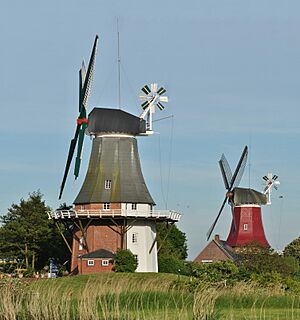
The smock mill is a newer type of tower mill. Instead of a stone tower, it has a wooden frame called a "smock." This frame is often covered with thatch, wood boards, or other materials like slate. Smock mills usually have eight sides.
The Dutch introduced smock windmills in the 1600s. They were cheaper to build than tower mills and could be built on wet ground. The bottom part of a smock mill was often made of brick, and the top part was wood. Their sloped shape made them strong. This design made them lighter and suitable for less stable ground.
Like some tower mills, smock mills also had a small turbine at the back. This helped the main mill turn to face the wind.
How Windmills Work
Sails

Most windmill sails have a frame where a sailcloth is spread. The miller can adjust how much cloth is spread out. This depends on how strong the wind is and how much power is needed. In older mills, the cloth was wrapped around a ladder-like structure. In colder places, wooden slats were used instead of cloth because they were easier to handle in freezing weather.
To adjust the sails, the windmill usually had to be stopped. But in the late 1700s and 1800s, new inventions made sails that could adjust automatically. One important invention was the "patent sails" by William Cubitt in 1807. These sails used connected shutters instead of cloth.
Most windmills have four sails. Some mills, especially in England and Germany, have five, six, or even eight sails. Having an even number of sails is helpful. If one sail gets damaged, the miller can remove it and the one opposite it. This keeps the mill balanced and allows it to keep working.

In the Netherlands, the way windmill sails are stopped can send signals.
- If the blades form a "+" sign (like 3, 6, 9, and 12 o'clock on a clock), it means the windmill is open for business.
- If the blades form an "X" shape, it means the windmill is closed or not working.
- A slight tilt of the sails (top blade at 1 o'clock) can signal joy, like the birth of a baby.
- A tilt of the blades to 11-2-5-8 o'clock signals mourning or a warning. This was used during World War II to warn people about Nazi searches.
Machinery
Inside a windmill, gears help transfer power from the spinning sails to the working parts. The sails are attached to a horizontal pole called the windshaft. This windshaft can be made of wood, or wood and iron, or just iron. A large wheel called the brake wheel is on the windshaft. It has teeth that turn another gear called a wallower. The wallower is on top of a vertical pole called the upright shaft.
In mills that grind grain, a large gear lower down the upright shaft turns smaller gears. These smaller gears then spin the millstones that grind the grain. Windmills can also power other machines. For example, a drainage mill uses gears to turn a scoop wheel or an Archimedes' screw to pump water. Sawmills use a special part called a crankshaft to move saws back and forth. Windmills have also been used to power paper mills, threshing machines, and to process oil, wool, and paint.
-
A drawing of the machinery inside the Beebe Windmill.
-
The windshaft, brake wheel, and brake blocks in smock mill d'Admiraal in Amsterdam.
-
Inside the Pantigo Windmill in East Hampton, New York.
Windmills: Rise and Fall


In the 1300s, windmills became very popular in Europe. At their peak in 1850, there were about 200,000 wind-powered mills. This was almost half the number of water wheels in use. Windmills were especially useful in places where there wasn't enough water, where rivers froze in winter, or in flat areas where rivers flowed too slowly.
With the start of the Industrial Revolution, new power sources like steam engines and later gasoline engines became popular. This meant that wind and water power became less important for industries. However, many windmills continued to be built until the late 1800s.
Today, many windmills are saved for their historical value. Some are just displays, while others are still working mills. Out of 10,000 windmills in the Netherlands around 1850, about 1,000 are still standing. Most of these are run by volunteers. Some still grind grain for businesses. Many drainage mills are kept as a backup for modern pumping stations.
The Zaan district in the Netherlands was one of the first industrialized areas in the world. By the late 1700s, it had about 600 wind-powered factories. But economic changes and the Industrial Revolution caused most of these to close. Only a few remain today.
Wind Turbines
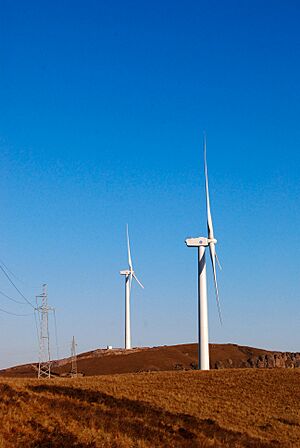
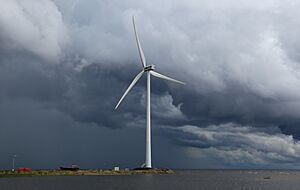
A wind turbine is like a modern windmill that is specially designed to make electricity. They are the next step in the long history of windmills. The first wind turbines were built in the late 1800s by people like James Blyth in Scotland and Charles F. Brush in the United States.
By the early 1900s, wind turbines were used in Denmark to power villages. In the 1930s, many farms in the United States used windmills to generate electricity. This was especially true in areas where power lines had not yet reached.
Modern wind turbines began to be mass-produced in 1979 by Danish companies. These early turbines were small compared to today's giants. Now, commercial turbines are much larger. Some can produce enough electricity for thousands of homes.
As the 2000s began, people became more worried about energy security, global warming, and running out of fossil fuels. This led to a big increase in interest in renewable energy sources like wind power. Today, many thousands of wind turbines are working around the world.
Materials
To make wind turbines more efficient, they are built bigger. They have taller towers and longer blades. Many are now placed offshore in the ocean. While these changes help them make more power, they also put more stress on the parts. Taller towers and longer blades can wear out faster. Offshore wind farms face stronger winds and faster corrosion from saltwater.
To make sure the turbines last a long time, the materials used for the blades must be chosen carefully. Wind turbine blades are usually made from strong, lightweight materials. These materials need to be stiff and tough. The best materials for blades are carbon fiber and glass fiber reinforced polymers (plastics). Glass fiber materials are often chosen because they cost less, even though carbon fiber is stronger for its weight.
Recycling Wind Turbine Blades
Wind turbine blades are very strong and durable, but this also means they are hard to recycle. When the Vindeby Offshore Wind Farm in Denmark was taken down in 2017, almost all of its fiberglass blades ended up in a landfill. This is not the best way to handle waste for the environment.
The main problem is that it's very difficult to separate the fiberglass materials in the blades. Experts say that Denmark will have to deal with about 46,400 tons of fiberglass waste from wind turbine blades over the next 20 to 25 years.
In the United States, old wind turbine blades also go to special landfills. This issue highlights the need for new ways to recycle these strong materials as more and more wind turbines reach the end of their useful life.
Windpumps
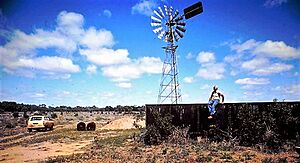
Windpumps have been used to pump water for a very long time. They were used as early as the 800s in areas that are now Afghanistan, Iran, and Pakistan. Their use spread across the Muslim world and later to China and India. In Europe, especially in the Netherlands and eastern England, windpumps were used from the Middle Ages to drain land for farming or building.
The "American windmill" or "wind engine" was invented in 1854 by Daniel Halladay. These were mostly used to pump water from wells. Larger versions could also saw wood, chop hay, or grind grain. In the late 1800s, steel blades and towers replaced wooden ones. At their peak in 1930, about 600,000 windpumps were in use in the United States.
Today, these windpumps are still widely used on farms and ranches in the United States, Canada, Southern Africa, and Australia. They have many blades, which helps them turn slowly but with a lot of power even in light winds. A gearbox at the top converts the spinning motion into an up-and-down movement. This movement is sent down a rod to a pump below, which lifts the water.
In Australia, companies like Southern Cross Windmills became famous for making these American-style windpumps. They became a symbol of Australian farms, especially for using water from the Great Artesian Basin.
|
See also
 In Spanish: Molino de viento para niños
In Spanish: Molino de viento para niños
- Don Quixote
- History of wind power
- List of windmills
- Sustainable energy
- Watermill


